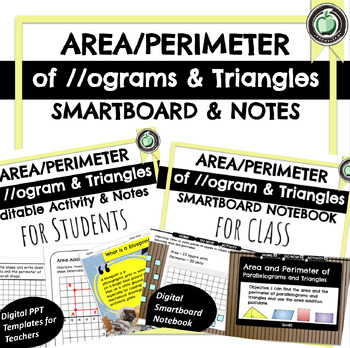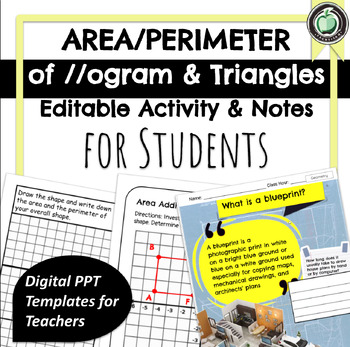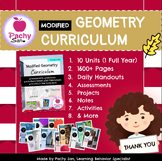Finding the Area & the Perimeter of Parallelograms and Triangles Bundle
Pachy San Store
50 Followers
Resource Type
Standards
CCSS3.G.A.1
CCSS4.G.A.1
CCSS4.G.A.2
CCSS5.G.B.4
CCSS6.G.A.1
Formats Included
- Google Slides™
Pachy San Store
50 Followers

Includes Google Apps™
This bundle contains one or more resources with Google apps (e.g. docs, slides, etc.).
Products in this Bundle (3)
Also included in
- Are you looking for a low-prep set of Geometry activities? Download this resource today, and watch as your students master both the content and skills in Geometry. I have included individual lessons for you to be able to find them on TPT.This Product Includes:⭐ 10 Units (1 Full Year)⭐ 1600+ Pages⭐ DPrice $110.00Original Price $564.60Save $454.60
Description
Need a fun and interactive way to teach area and perimeter of parallelograms and triangles. You can start with this lesson. Students can come up to the board to draw or move squares to create a shape. File does require Notebook software.
This bundle comes with my graphic organizers to go with this Smartboard notebook.
It's designed for a standalone lesson, making it perfect for any classroom setting. Plus, complement your teaching with our sleek graphic organizers tailored specifically for this lesson. Access them in the accompanying Notebook software file. Elevate your teaching experience today!
This bundle includes:
⭐ Interactive Smartboard Activity
⭐ Graphic Organizers to go with the activity
Total Pages
Answer Key
N/A
Teaching Duration
N/A
Report this resource to TPT
Reported resources will be reviewed by our team. Report this resource to let us know if this resource violates TPT’s content guidelines.
Standards
to see state-specific standards (only available in the US).
CCSS3.G.A.1
Understand that shapes in different categories (e.g., rhombuses, rectangles, and others) may share attributes (e.g., having four sides), and that the shared attributes can define a larger category (e.g., quadrilaterals). Recognize rhombuses, rectangles, and squares as examples of quadrilaterals, and draw examples of quadrilaterals that do not belong to any of these subcategories.
CCSS4.G.A.1
Draw points, lines, line segments, rays, angles (right, acute, obtuse), and perpendicular and parallel lines. Identify these in two-dimensional figures.
CCSS4.G.A.2
Classify two-dimensional figures based on the presence or absence of parallel or perpendicular lines, or the presence or absence of angles of a specified size. Recognize right triangles as a category, and identify right triangles.
CCSS5.G.B.4
Classify two-dimensional figures in a hierarchy based on properties.
CCSS6.G.A.1
Find the area of right triangles, other triangles, special quadrilaterals, and polygons by composing into rectangles or decomposing into triangles and other shapes; apply these techniques in the context of solving real-world and mathematical problems.






